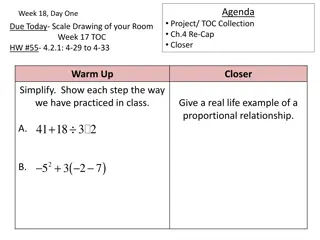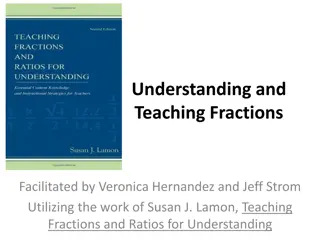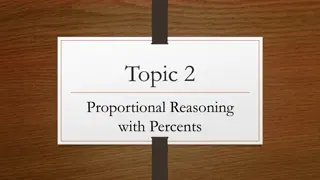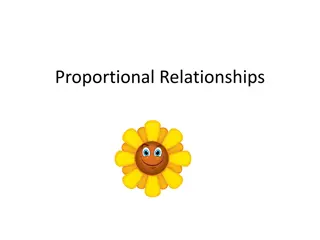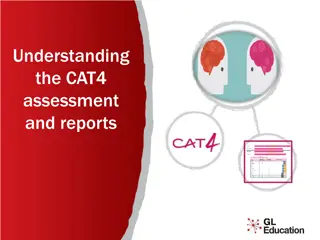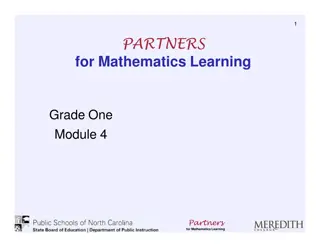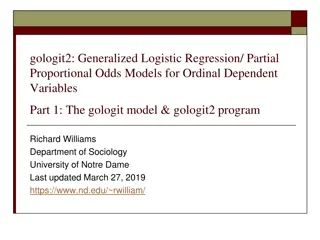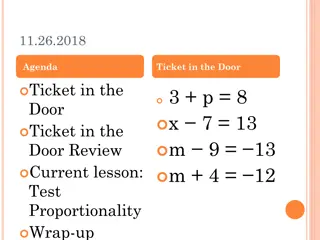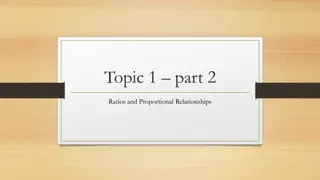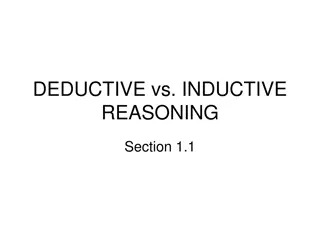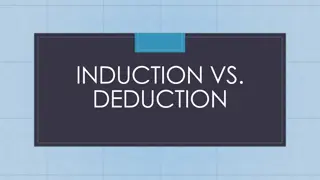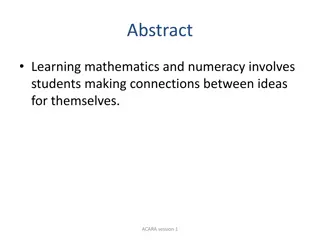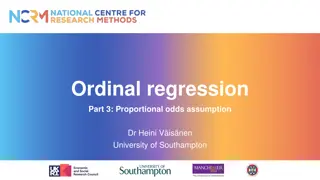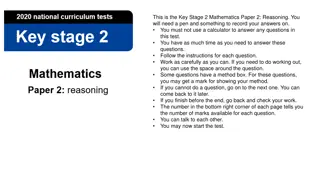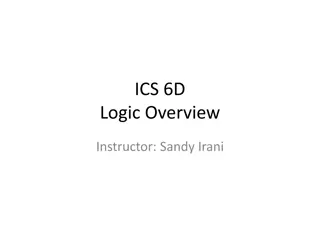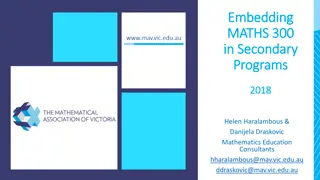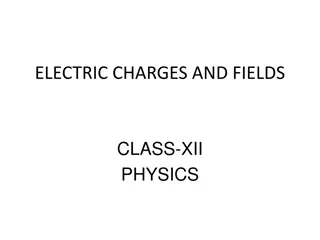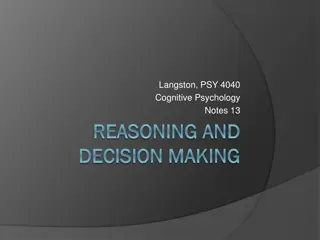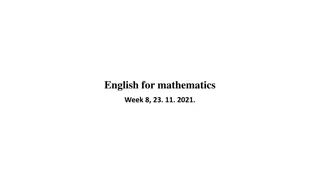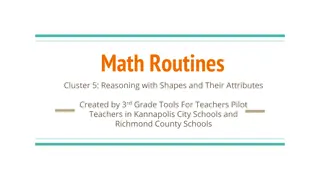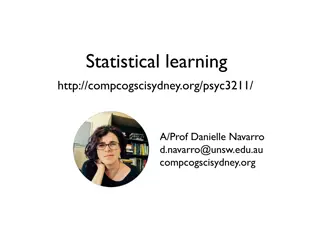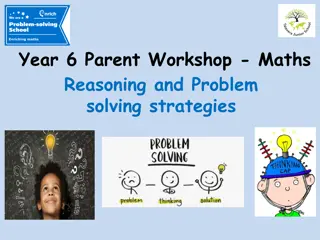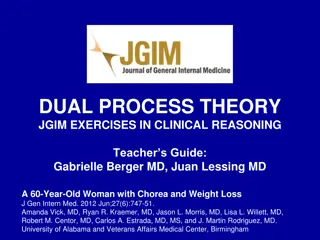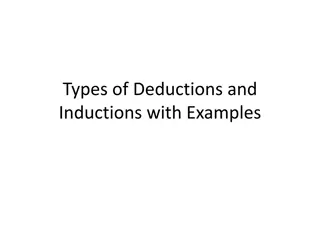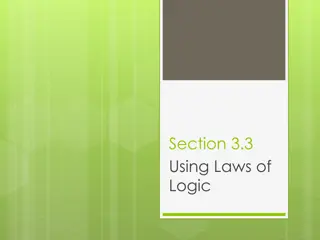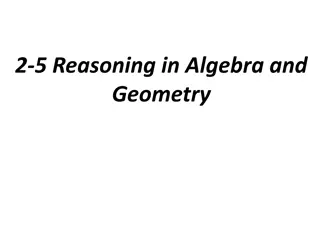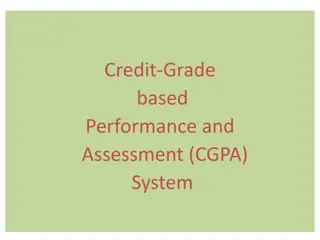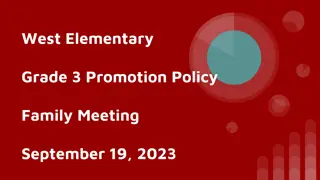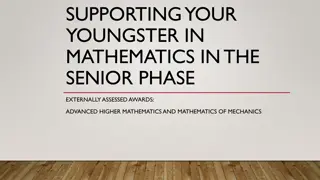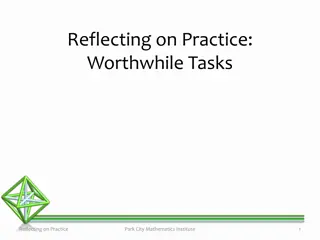Exploring Proportional Reasoning in Grade 8 Mathematics Learning
Dive into the world of proportional reasoning in Grade 8 mathematics with a focus on identifying better buys, strategies for decision-making, and the importance of developing proportional thinking skills. Discover the significance of proportional reasoning as a key element in the curriculum, its implications on algebraic concepts, and the need for effective instructional practices to foster students' ability to reason proportionally.
- Proportional Reasoning
- Grade 8 Mathematics
- Decision Making
- Curriculum Development
- Instructional Strategies
Uploaded on Sep 16, 2024 | 0 Views
Download Presentation

Please find below an Image/Link to download the presentation.
The content on the website is provided AS IS for your information and personal use only. It may not be sold, licensed, or shared on other websites without obtaining consent from the author. Download presentation by click this link. If you encounter any issues during the download, it is possible that the publisher has removed the file from their server.
E N D
Presentation Transcript
PARTNERS PARTNERS forMathematicsLearning Grade8 Module4 Partners Partners forMathematicsLearning
2 Module4 ProportionalReasoning Partners Partners forMathematicsLearning
3 WhichIsaBetterBuy? 12ticketsfor$15.00or20ticketsfor $23.00? Partners Partners forMathematicsLearning
4 WhichisaBetterBuy? Whatisyouranswer? Howdidyouobtainyouranswer? Whataresomestrategiesthatyour studentsmightuse? Partners Partners forMathematicsLearning
5 WhichIsaBetterBuy? Ifastudentvalueseachticketasworth $1.00,whatmightthestudentsayabout eachdealusing Additivereasoning Proportionalreasoning Partners Partners forMathematicsLearning
6 ProportionalThinking Asdifferentwaystothinkaboutproportions areconsideredanddiscussed,teachers shouldhelpstudentsrecognizewhenand howvariouswaysofreasoningabout proportionsmightbeappropriatetosolve problems PSSM,2000 Partners Partners forMathematicsLearning
7 CapstoneoftheCurriculum! Proportionalreasoninghasbeenreferred toasthecapstonefortheelementary curriculumandthecornerstoneofalgebra andbeyond. VandeWalle,J.A(2004).ElementaryandMiddleSchool Mathematics:TeachingDevelopmentally.PearsonLearningInc. Partners Partners forMathematicsLearning
8 Amazing Isn tIt? Itisestimatedthatmorethanhalfofthe adultpopulationcannotbeviewedas proportionalthinkers.Thatmeansthatwe donotacquirethehabitsandskillsof proportionalreasoningsimplybygetting older. VandeWalle,J.A(2004).ElementaryandMiddleSchool Mathematics:TeachingDevelopmentally.PearsonLearningInc. Partners Partners forMathematicsLearning
9 ResearchSays Researchindicatesthatinstructioncanhavean effect,especiallyifrulesandalgorithmsfor fractioncomputation,forcomparingratios,and forsolvingproportionsaredelayed.Premature useofrulesencouragesstudentstoapplyrules withoutthinkingand,thus,theabilitytoreason proportionallyoftendoesnotdevelop. VandeWalle,J.A(2004).ElementaryandMiddleSchool Mathematics:TeachingDevelopmentally.PearsonLearningInc. Partners Partners forMathematicsLearning
10 TeachingEffectively Instructioninsolvingproportionsshouldinclude methodsthathaveastrongintuitivebasis PSSM,2000 Inagroupofstudentswhocansuccessfully applyanalgorithm,howcanyoudistinguish betweenthosewhocanreasonproportionally andthosewhocannot? Partners Partners forMathematicsLearning
11 OneInchTall byShelSilverstein Ifyouwereonlyoneinchtall,you dridea wormtoschool Theteardropofacryingant wouldbeyourswimmingpool. Partners Partners forMathematicsLearning
12 WouldThisBeTrue? Ifyouwereonlyoneinchtall,youcouldwear athimbleonyourhead Partners Partners forMathematicsLearning
13 HowAboutThis? Ifyouwereonlyoneinchtall,itwouldtake aboutamonthtogetdowntothestore Partners Partners forMathematicsLearning
14 Let sInvestigate! Ifyouwereonlyoneinchtall Couldyourideawormtoschool? Couldyouwearathimbleonyourhead? Wouldittakeamonthtogettothestore? Partners Partners forMathematicsLearning
15 JustTheFacts,Ma am! Whatinformationwillyouneedtosolve theseproblems? Partners Partners forMathematicsLearning
16 TimeToInvestigate Partners Partners forMathematicsLearning
17 Let sTalk Whatareourconclusions? Couldyourideawormtoschool? Couldyouwearathimbleonyourhead? Wouldittakeamonthtogettothestore? Partners Partners forMathematicsLearning
18 IncreasedStudentUnderstanding Problemsthatinvolveconstructingor interpretingscaledrawingsofferstudents opportunitiestouseandincreasetheir knowledgeofsimilarity,ratio,and proportionality PSSM Partners Partners forMathematicsLearning
19 TangramTime! Partners Partners forMathematicsLearning
20 TangramTime! Partners Partners forMathematicsLearning
21 InvestigationandExploration Studentswholearnedthrough investigationandexplorationwerenot onlymoresuccessfulatgivingcorrect responsestoproportionalreasoning tasksbutalsobetterabletojustify thoseanswers. Fey,J.T.,Miller,J.L.(2000).ProportionalReasoning.Mathematics TeachingintheMiddleSchool.5(5),312 Partners Partners forMathematicsLearning
22 ContinuingOurInvestigations Partners Partners forMathematicsLearning
23 TheSierpinskiTriangleActivity Partners Partners forMathematicsLearning
24 TheSierpinskiTriangle STAGE0 Usingdotpaper,constructanequilateral triangleofsidelength16 Whatistheareaofthistriangle? Partners Partners forMathematicsLearning
25 TheSierpinskiTriangle STAGE1 Markthemidpointofeachsideofthe triangle Jointhemidpointsto form4smallertriangles Partners Partners forMathematicsLearning
26 TheSierpinskiTriangle STAGE1 Determinesomerelationshipsbetweenthenew trianglesandtheoriginaltriangle Similarity? Congruence? Whatistheareaofeachnewtriangle? Whatfractionoftheoriginaltriangledoeseach newtrianglerepresent? Partners Partners forMathematicsLearning
27 TheSierpinskiTriangle STAGE1 Remove(shade)thecentertriangle Whatfractionoftheoriginal areaisnotshaded? Updatethechart Partners Partners forMathematicsLearning
28 TheSierpinskiTriangle STAGE2 Bisecteachsideofthe new (unshaded) triangles Jointhemidpointsineachtoformatotal of12smallertriangles(16ifyoudivided thelargershadedtriangle) Partners Partners forMathematicsLearning
29 TheSierpinskiTriangle STAGE2 Determinesomerelationships betweenthenewtriangles andtheoriginaltriangle Remove(shade)thecentertriangles Whatistheareaofthenewtriangle? Whatfractionoftheoriginalareaisnot shaded? Partners Partners forMathematicsLearning
30 TheSierpinskiTriangle STAGE3 Bisecteachsideofthe new (unshaded) triangles Jointhemidpointsineachtoformatotal of_?_smallertriangles Partners Partners forMathematicsLearning
31 TheSierpinskiTriangle STAGE3 Remove(shade)thecentertriangles Whatfractionoftheoriginalareaisnot shaded? Updatethechart Partners Partners forMathematicsLearning
32 TheSierpinskiTriangle Isanexampleofafractal(aself-similar object) Ingeneral,afractalisageometricobject whosepartsarereduced-sizedcopiesof thewhole Givesomereal-lifeexamplesoffractals Partners Partners forMathematicsLearning
33 TheSierpinskiTriangle Determineamathematicalrelationshipfor Thenumberoftrianglesateachstage Theareaofeachnewtriangle Thefractionoftheoriginalareathateachnew trianglerepresents Thefractionoftheoriginalareathatisnot shaded Partners Partners forMathematicsLearning
34 TheSierpinskiTriangle Whatpatternsemerge? Whatiftheiterationscontinued Whatwouldbetheareaofoneofthesmallest trianglesinthe4thiteration? Whatfractionoftheoriginaltrianglewouldnot beshadedatthisstage? Whataboutthe100thiteration? Whatishappeningtotheareaoftheun- shadedregionasthenumberofiterations grows? Partners Partners forMathematicsLearning
35 TheSierpinskiTriangle Whatwillyourstudentsthinkofthis activity? Whatmathematicalconceptsarecovered inthisactivity? Willyougivethisactivityatry? Partners Partners forMathematicsLearning
36 TheKochSnowflake Partners Partners forMathematicsLearning
37 TheKochSnowflake STAGE0 Usingdotpaper,constructanequilateral triangleofsidelength9 Whatistheperimeterofthistriangle? Partners Partners forMathematicsLearning
38 TheKochSnowflake STAGE1 Trisecteachsideofthetriangle Remove(erase)themiddlesegmentof eachside Partners Partners forMathematicsLearning
39 TheKochSnowflake STAGE1 Createanewequilateraltriangleoneach sideoftheoriginaltrianglebyaddingtwo segmentsofthesamelengthasthe erasedsegmentontotheside Theerasedsegmentwillbethebaseof thenewequilateraltriangle Partners Partners forMathematicsLearning
40 TheKochSnowflake Thenewshapewillbea six-pointedstar Whatistheperimeter ofthestar? Partners Partners forMathematicsLearning
41 TheKochSnowflake STAGE2 ReiteratetheprocessdescribedinStage1 Firsttrisectofeachsideofthetriangle Remove(erase)themiddlesegmentof eachside Partners Partners forMathematicsLearning
42 TheKochSnowflake STAGE2 Createanewequilateraltriangleoneach sideofthe6-pointedstarbyaddingtwo segmentsofthesamelengthasthe erasedsegmentontotheside Theerasedsegmentwillbethebaseof thenewequilateraltriangle Partners Partners forMathematicsLearning
43 TheKochSnowflake STAGE2 Thenewfigureshouldlooklikea snowflake Whatistheperimeterofthenewfigure? Partners Partners forMathematicsLearning
44 TheKochSnowflake Lookatthevalueoftheperimeter ateachstage Isthereapatternhere? Theperimeterofeachfigureis__?__ timestheperimeterofthepreviousfigure Partners Partners forMathematicsLearning
45 TheKochSnowflake Howmanyiterationswouldittaketoobtain aperimeterof100units?(orascloseto 100asyoucanget) Asyouperformmoreandmoreiterations, whathappenstothevalueoftheperimeter andthearea? Partners Partners forMathematicsLearning
46 TheKochSnowflake Aninfiniteperimeterenclosesafinitearea nowthat samazing! Whatwillyourstudentsthinkofthisactivity? Willyougivethisactivityatry? Partners Partners forMathematicsLearning
47 SummarizingtheWork Whatmathematicalconceptsandskillsare addressedintheseactivities? Understandingofandcomputationwithreal numbers Understandingofanduseofmeasurement concepts Understandofandusepropertiesand relationshipsingeometry Partners Partners forMathematicsLearning
48 ProportionalReasoningActivities OneInchTall Tangrams SierpinskiTriangle KochSnowflake Whatareyourfavoriteproportional reasoningactivities? Partners Partners forMathematicsLearning
49 WhatBigIdeasAreAddressed? Fluencywithdifferenttypesofreasoning (quantitative,additive,multiplicative, proportional)isnecessaryformathematical development Fluency(accuracy,efficiency,flexibility) usingoperationswithrationalnumbers becomessolidifiedinthemiddlegrades Partners Partners forMathematicsLearning
50 BIGIdeas Twodimensionalfiguresareviewedinthe rectangularcoordinateplaneand transformationsoftwodimensionalfigures withintheplanemayproducefiguresthat aresimilarand/orcongruenttotheoriginal figure Partners Partners forMathematicsLearning


